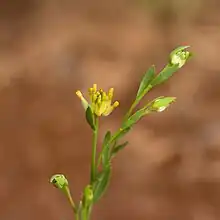Pimelea simplex
Pimelea simplex, commonly known as desert rice-flower,[2] is a species of flowering plant in the family Thymelaeaceae and is endemic to inland Australia. It is a herb or semi-woody annual with narrowly elliptic to linear leaves, and compact heads of densely hairy white to yellowish-green flowers.
| Pimelea simplex | |
|---|---|
 | |
| In the Gawler Ranges | |
| Scientific classification | |
| Kingdom: | Plantae |
| Clade: | Tracheophytes |
| Clade: | Angiosperms |
| Clade: | Eudicots |
| Clade: | Rosids |
| Order: | Malvales |
| Family: | Thymelaeaceae |
| Genus: | Pimelea |
| Species: | P. simplex |
| Binomial name | |
| Pimelea simplex | |
| Synonyms[1] | |
|
Banksia simplex (F.Muell.) Kuntze | |
Description
Pimelea simplex is herb or semi-woody annual that typically grows to a height of 5–50 cm (2.0–19.7 in) and has hairy young stems. The leaves are arranged alternately along the stems and are usually narrowly elliptic, 3–30 mm (0.12–1.18 in) long and 0.8–3 mm (0.031–0.118 in) wide on a short petiole. The flowers are bisexual and borne on the ends of branches in dense clusters of many white to yellowish-green flowers, the rachis densely covered with fine hairs. The floral tube is 2.5–5.0 mm (0.098–0.197 in) long, the sepals erect and 0.4–1 mm (0.016–0.039 in) long. Flowering occurs from June to October.[2][3][4][5]
Taxonomy
Pimelea simplex was first formally described in 1853 by Ferdinand von Mueller in the journal Linnaea.[6][7] The specific epithet, (simplex) means "simple" or "undivided".[8]
In 1983, S. Threlfall described two subspecies of P. simplex in the journal Brunonia, and the names are accepted by the Australian Plant Census:
- Pimelea simplex subsp. continua (J.M.Black) Threlfall[9] (previously known as Pimelea continua J.M.Black), is a sturdy plant with flower clusters usually 10–18 mm (0.39–0.71 in) long at maturity, on peduncles up to 30 mm (1.2 in) long, the individual flowers 5–7 mm (0.20–0.28 in) long.[10][11]
- Pimelea simplex F.Muell. subsp. simplex[12] is a slender plant with flower clusters up to 10 mm (0.39 in) long at maturity, on peduncles up to 15 mm (0.59 in) long, the individual flowers 4–6 mm (0.16–0.24 in) long.[13][14]
Distribution and habitat
Subspecies continua tends to grow on soils on heavier texture than subsp. simplex. Both species are found in inland Australia, but subsp. simpex has a wider distribution, occurring throughout most of South Australia, western New South Wales, central and south-western Queensland, and the far north-west of Victoria. Subspecies continua does not appear to occur in Victoria but is known from a few collections in the Northern Territory.[10][13][11][14][3][15]
Conservation status
Pimelea simplex is listed as "near threatened" under the northern Territory Territory Parks and Wildlife Conservation Act.[16]
References
- "Pimelea simplex". Australian Plant Census. Retrieved 5 April 2023.
- Harden, Gwen. "Pimelea simplex". Royal Botanic Garden Sydney. Retrieved 5 April 2023.
- Rye, Barbara L. "Pimelea simplex". Flora of Australia. Australian Biological Resources Study, Department of Agriculture, Water and the Environment: Canberra. Retrieved 5 April 2023.
- "Pimelea simplex". State Herbarium of South Australia. Retrieved 5 April 2023.
- Entwisle, Timothy J.; Stajsic, Val. "Pimelea simplex subsp. simplex". Royal Botanic Gardens Victoria. Retrieved 5 April 2023.
- "Pimelea simplex". APNI. Retrieved 5 April 2023.
- von Mueller, Ferdinand (1853). "Diagnoses et descriptiones plantarum novarum, quas in Nova Hollandia australi praecipue in regionibus interioribus". Linnaea: ein Journal für die Botanik in ihrem ganzen Umfange, oder Beiträge zur Pflanzenkunde. 25: 443. Retrieved 5 April 2023.
- William T. Stearn (1992). Botanical Latin. History, grammar, syntax, terminology and vocabulary (4th ed.). Portland, Oregon: Timber Press. p. 950.
- "Pimelea simplex subsp. continua". Australian Plant Census. Retrieved 5 April 2023.
- Harden, Gwen. "Pimelea simplex subsp. continua". Royal Botanic Garden Sydney. Retrieved 5 April 2023.
- "Pimelea simplex subsp. continua". State Herbarium of South Australia. Retrieved 5 April 2023.
- "Pimelea simplex subsp. simplex". Australian Plant Census. Retrieved 5 April 2023.
- Harden, Gwen. "Pimelea simplex subsp. simplex". Royal Botanic Garden Sydney. Retrieved 5 April 2023.
- "Pimelea simplex subsp. simplex". State Herbarium of South Australia. Retrieved 5 April 2023.
- Rye, Barbara L. "Pimelea simplex subsp. continua". Flora of Australia. Australian Biological Resources Study, Department of Agriculture, Water and the Environment: Canberra. Retrieved 5 April 2023.
- "Pimelea simplex". Northern Territory Government. Retrieved 5 April 2023.